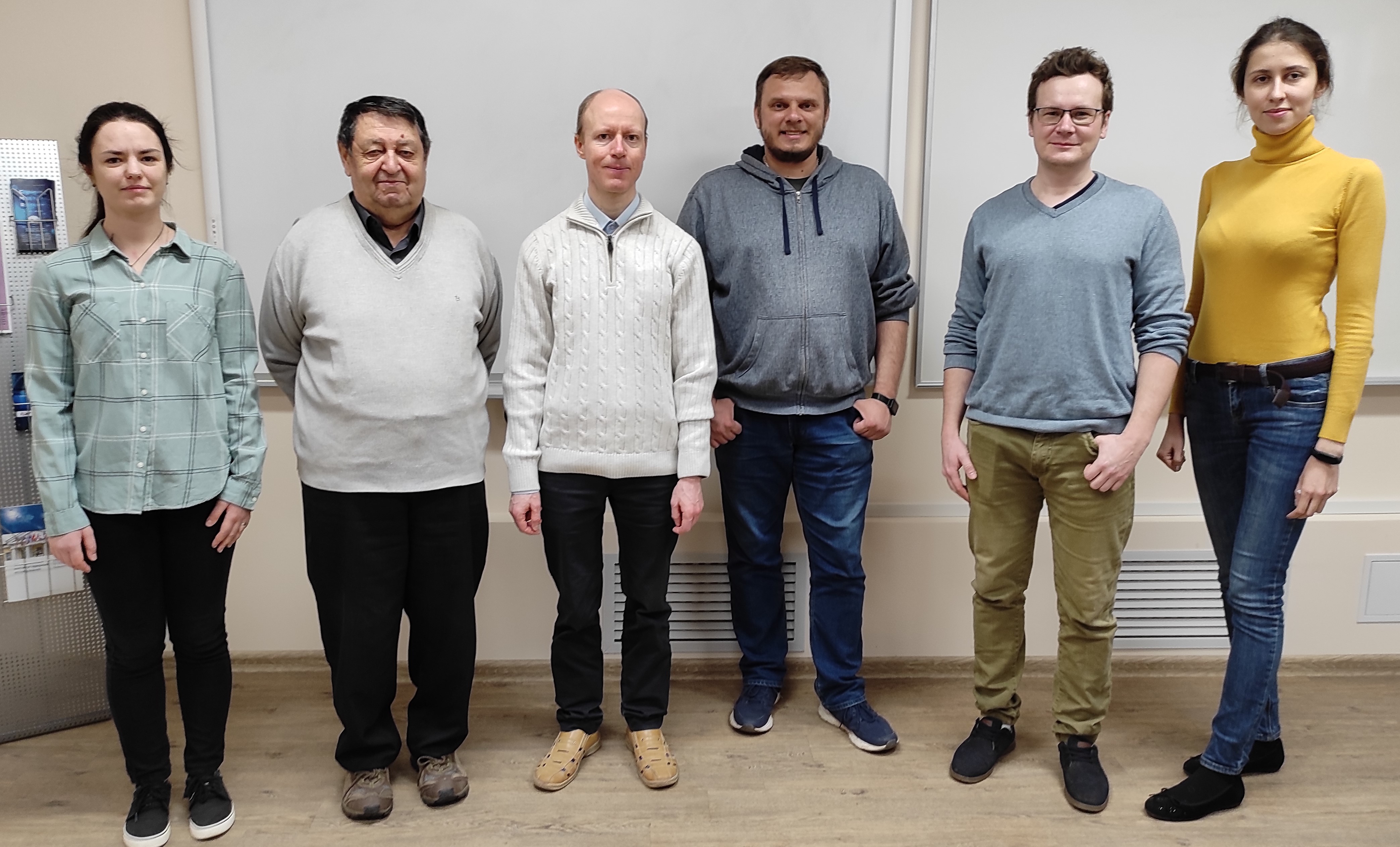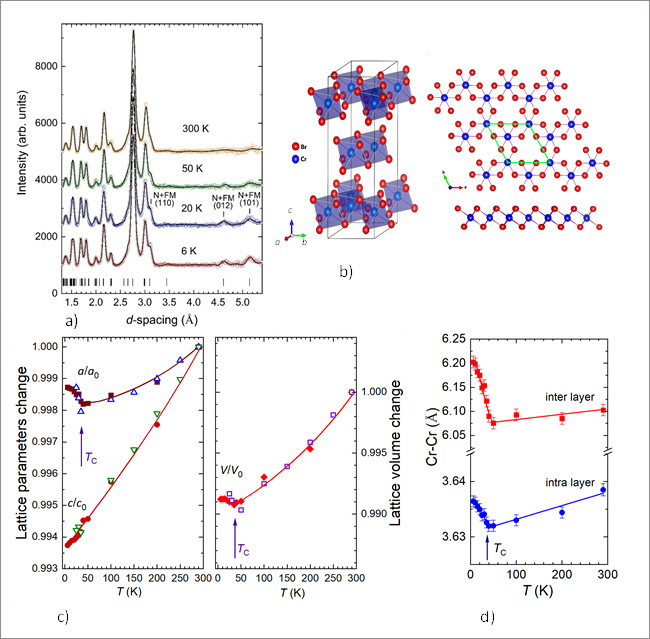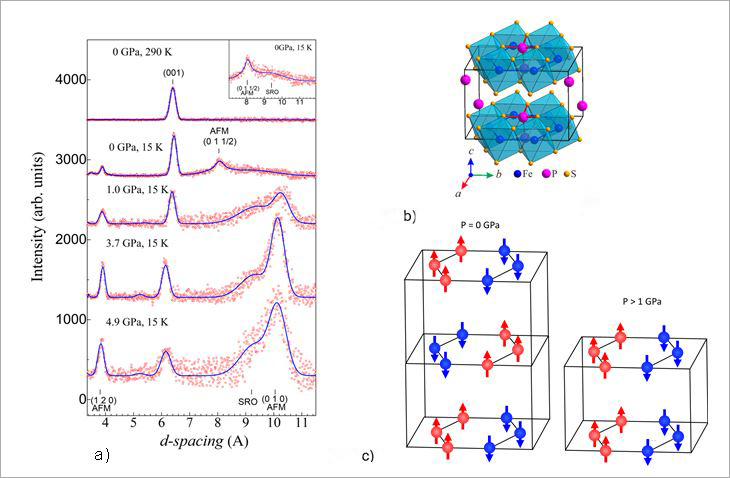FLNP scientists discovered new properties of magnetic analogues of graphene
Publications, 22 April 2021
Unusual properties of graphene-like van der Waals magnetic materials: neutron investigations
Recently, a study “Spin-induced negative thermal expansion and spin-phonon coupling in van der Waals material CrBr3” by a group of researchers from the Frank Laboratory of Neutron Physics (D. P. Kozlenko, O. N. Lis, S. E. Kichanov, E. V. Lukin, N. M. Belozerova and B. N. Savenko) was published in one of the latest issues of the journal npj Quantum Materials (Nature Publishing Group).
 In the photo from left to right: O. N. Lis, B. N. Savenko, D. P. Kozlenko, S. E. Kichanov, E. V. Lukin, N. M. Belozerova
In the photo from left to right: O. N. Lis, B. N. Savenko, D. P. Kozlenko, S. E. Kichanov, E. V. Lukin, N. M. Belozerova
The object of this study is a model material CrBr3 from the family of low-dimensional van der Waals magnetic compounds. At present, the investigation of van der Waals magnets is one of the most topical research areas in the field of condensed matter physics and materials science, since they are in fact magnetic analogues of graphene – a unique two-dimensional material, the discovery of which was awarded the Nobel Prize in Physics in 2010. Recent studies of the two-dimensional forms of van der Waals magnets have shown that they retain magnetic order at sufficiently high temperatures down to the atomic monolayer limit. In addition, a wide variety of new physical phenomena were discovered in these materials with changes in thermodynamic parameters (temperature and pressure), including superconductivity, topological spin excitations, skyrmion states, dielectric-metal transition, and spin crossover.
Neutron diffraction studies of the structural and magnetic properties of the CrBr3 compound carried out at the JINR basic facility – the IBR-2 pulse reactor – revealed unusual effects – anomalous behavior of the structural characteristics in the vicinity of the ferromagnetic ordering temperature ТC, and negative thermal expansion of the crystal lattice volume and quasi-two-dimensional van der Waals layers in the temperature range of T < TC. It should be noted that negative thermal expansion is a relatively rare physical effect found only in a few classes of materials. While in most crystalline materials we observe an increase in the volume of the crystal lattice and characteristic interatomic distances with rising temperature (positive thermal expansion), in exceptional cases, as for CrBr3, for a certain range of thermodynamic parameters, the opposite effect can occur (negative thermal expansion), when the volume and interatomic distances decrease with increasing temperature (Fig. 1). It is interesting to note that graphene also exhibits negative thermal expansion, and the coefficient of linear thermal expansion of atomic layers in CrBr3 for T
 Fig. 1. a) Neutron diffraction patterns of CrBr3 measured at various temperatures and calculated profiles refined by the Rietveld method. b) The rhombohedral crystal structure of CrBr3 of R3 symmetry. Right: top and side views of van der Waals atomic layers. c) Temperature dependences of the parameters and unit cell volume of the CrBr3 crystal lattice, normalized to the corresponding values at room temperature. d) Temperature dependences of the distances between magnetic Cr ions inside van der Waals layers (intralayer) and between layers (interlayer).
Fig. 1. a) Neutron diffraction patterns of CrBr3 measured at various temperatures and calculated profiles refined by the Rietveld method. b) The rhombohedral crystal structure of CrBr3 of R3 symmetry. Right: top and side views of van der Waals atomic layers. c) Temperature dependences of the parameters and unit cell volume of the CrBr3 crystal lattice, normalized to the corresponding values at room temperature. d) Temperature dependences of the distances between magnetic Cr ions inside van der Waals layers (intralayer) and between layers (interlayer).
Also, recently, the results of the study on the structural and magnetic properties of the van der Waals antiferromagnet FePS3 under high pressures, carried out jointly by a team of researchers from FLNP (D.P. Kozlenko, S.E. Kichanov, B.N.Savenko) with research groups from Seoul National University (Republic of Korea), University of Cambridge (Great Britain), Institute of Laue-Langevin and Sorbonne University (France) were published in the journal Physical Review X. The existence of a new structural modification of FePS3 with a monoclinic crystal structure in the pressure range above P = 1 GPa (10000 atm) was revealed. Structural rearrangement under high pressure leads to a change in the nature of antiferromagnetic ordering from quasi-two-dimensional to three-dimensional, which manifests itself in a twofold decrease in the size of the unit cell of the magnetic lattice along the z direction, Fig. 2. At higher pressures (P > 14 GPa), in the region of the insulator-metal transition, the suppression of antiferromagnetic order and the formation of a phase with short-range magnetic order were also observed.
 Fig. 2. (a) Neutron diffraction patterns of FePS3 obtained at various pressures and temperatures and profiles calculated by the Rietveld method. (b) Monoclinic structure of FePS3 of C2/m symmetry. (c) Magnetic structure of FePS3 at normal and high pressures.
Fig. 2. (a) Neutron diffraction patterns of FePS3 obtained at various pressures and temperatures and profiles calculated by the Rietveld method. (b) Monoclinic structure of FePS3 of C2/m symmetry. (c) Magnetic structure of FePS3 at normal and high pressures.
More details on the results of these studies can be found in:
[1] D.P. Kozlenko, O.N. Lis, S.E. Kichanov, E.V.Lukin, N.M.Belozerova, B.N.Savenko “Spin induced negative thermal expansion and spin-phonon coupling in van der Waals material CrBr3”, npj Quantum materials 6: 19 (2021), https://doi.org/10.1038/s41535-021-00318-5.
[2] M.J.Coak, D.M.Jarvis, H.Hamidov, A.R.Wildes, J.A.M.Paddison, C.Liu, C.R.S.Haines, N.T.Dang, S.E.Kichanov, B.N.Savenko, S.Lee, M.Kratochvilova, S.Klotz, T.Hansen, D.P.Kozlenko, J.-G.Park, and S.S.Saxena “Emergent Magnetic Phases in Pressure-Tuned van der Waals Antiferromagnet FePS3”, Physical Review X 11, 011024 (2021), https://doi.org/10.1103/PhysRevX.11.011024.
The articles were published in accordance with the International licence Creative Commons Attribution 4.0.